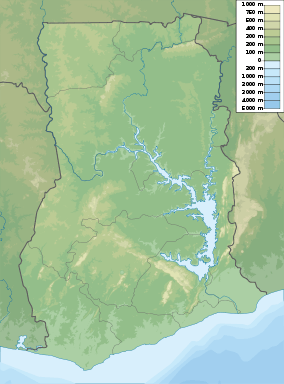Bia National Park
| Bia National Park | |
|---|---|
 | |
| Location | Western Region of Ghana |
| Nearest city | Sekondi-Takoradi |
| Coordinates | 6°5′N 3°6′W / 6.083°N 3.100°WCoordinates: 6°5′N 3°6′W / 6.083°N 3.100°W |
| Area | 563 km² |
| Established | 1974 |
Bia National Park is a national park in the Western Region of Ghana. It is also a biosphere reserve with a 563 square kilometer resource reserve. It has some of Ghana's last remnants of relatively untouched forest complete with its full diversity of wildlife. Some of the tallest trees left in West Africa are found in this national park.[1][2]
Geography
Bia National Park is located near the Ivorian border, the Bia River, and its tributaries, which flow into the Côte d'Ivoire drainage area. It is found in the transitional zone between moist-evergreen and moist semi-deciduous forest types.[3] Access to the park from Kumasi is through Bibiani, Sefwi Wiawso to Sefwi Asempanaye or Goaso through Sankore to Sefwi Asempanaye. From Sunyani it can be reached through Brekum, Wanfi, Adabokrom and Debiso. From Côte d'Ivoire the park can be reached through Osei Kojokrom and Debiso.
History
Bia was created in 1935 and named after the Bia River which drains the area.[4] It became an official national park in 1974. Intensive farming destroyed much of the original vegetation in the park.[5] However, since 1975, no human activities like farming or logging have taken place.[6] In 1985 the park was named a biosphere reserve and a UNESCO world heritage site.[6]
Wildlife
There are 62 species of mammals (including 10 primate species) known to live in the park, and over 160 species of birds, including the endangered white-breasted guinea fowl. The park is also the only known home of the newly discovered species of lizard, Agama sylvanus.[7] Ghana's major protected forest antelope communities also live in the park.[8]
Bibliography
| Wikimedia Commons has media related to Bia National Park. |
- Notes
- ↑ "Bia National Park". tourism.thinkghana.com. Archived from the original on 23 January 2010. Retrieved 2 January 2010.
- ↑ "Wildlife and Nature Reserves". ghanaexpeditions.com. Retrieved 2 January 2010.
- ↑ "Bia National Park & Resource Reserve/Biosphere Reserve". fcghana.com. The Forestry Commission of Ghana. Archived from the original on 27 January 2010. Retrieved 2 January 2010.
- ↑ "National Parks in Ghana". chm-cbd.net. Ghanaian Clearing-House Mechanism. Retrieved 2 January 2010.
- ↑ "Ghana National Game & Wildlife Parks". ghanaembassy.or.jp. The Ghana Embassy in Japan. Retrieved 12 January 2010.
- 1 2 Boyle & Boontawee 1995, p. 247
- ↑ "About Ghana". travelcareholdings.com. TravelCare Holdings. Retrieved 4 January 2010.
- ↑ East 1990, p. 70
- References
- Boyle, Timothy James Butler; Boontawee, B. (1995). Measuring and monitoring biodiversity in tropical and temperate forests: proceedings of a IUFRO symposium held at Chiang Mai, Thailand, August 27th — September 2nd, 1994 (1995 ed.). CIFOR. ISBN 979-8764-01-3. - Total pages: 395
- East, Rod;(IUCN/SSC Specialist Antelope Group) (1990). Antelopes: Global Survey and Regional Action Plans Part 3. West and Central Africa (1990 ed.). IUCN. ISBN 2-8317-0016-7. - Total pages: 171